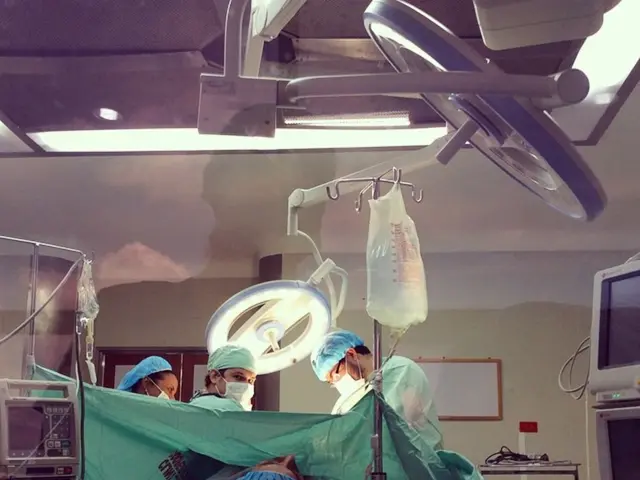Alternative procedures for detecting colorectal cancer: A look at seven options beyond colonoscopy
## Title: Comparing Colorectal Cancer Screening Methods: A Comprehensive Overview
In the realm of colorectal cancer (CRC) screening, various methods are available, each with its unique advantages and disadvantages compared to the traditional gold standard, colonoscopy. This article provides a comparative overview of the most common screening methods.
### Colonoscopy vs. Alternative Methods
| Method | Pros | Cons | |---------------------------------|-----------------------------------------------------------------------------------------------|---------------------------------------------------------------------------------------------| | **Colonoscopy** | - Highest sensitivity and specificity for CRC and adenomas
- Enables biopsy and polyp removal during procedure
- Long interval (10 years) | - Invasive, requires sedation/analgesia
- Higher risk of perforation/bleeding
- Expensive, requires bowel prep and specialist | | **Fecal Immunochemical Test (FIT)** | - Noninvasive, easy home collection
- No dietary/medication restrictions
- High sensitivity for detecting CRC, especially with annual testing
- Low cost, can be mailed to patients[2][4] | - Lower adenoma detection than colonoscopy
- Requires annual or biennial testing for best outcomes[2]
- False positives/negatives possible | | **Fecal Occult Blood Test (gFOBT, single-specimen)** | - Simple, inexpensive, noninvasive
- Widely available | - Low sensitivity, especially for early lesions
- Requires strict dietary/medication preparation
- High false-positive rate | | **Stool DNA Testing (e.g., Cologuard, ColoSense)** | - Noninvasive, detects DNA/RNA biomarkers
- Good sensitivity for CRC and advanced adenomas[1]
- No dietary restrictions | - Expensive
- Lower specificity than colonoscopy
- Still requires colonoscopy for positive results
- Less effective than annual FIT or colonoscopy[1] | | **Flexible Sigmoidoscopy** | - Less invasive than colonoscopy
- No sedation needed
- Detects distal colon lesions well | - Misses proximal colon lesions
- Requires bowel prep
- Shorter screening interval than colonoscopy | | **CT Colonography (Virtual Colonoscopy)** | - Noninvasive
- Good visualization of entire colon
- No sedation required | - Requires bowel prep
- Radiation exposure
- Cannot biopsy or remove polyps, requires follow-up colonoscopy | | **Double-Contrast Barium Enema** | - Noninvasive
- No sedation required | - Low sensitivity for small polyps
- Requires bowel prep
- Rarely used now compared to other methods |
### Additional Considerations
**Effectiveness:** - A large Spanish trial found that biennial FIT was as effective as a one-time colonoscopy in reducing CRC mortality, highlighting the value of stool tests, especially when adherence is high[2]. - Stool DNA/RNA tests and FIT are both considered effective alternatives for average-risk individuals, though colonoscopy remains the most comprehensive method. - Novel noninvasive tests (e.g., FIT-DNA, FIT-RNA) are cost-effective compared to colonoscopy and flexible sigmoidoscopy, but colonoscopy still offers the best detection of advanced adenomas and the opportunity for therapeutic intervention[5].
**Patient Factors:** - Colonoscopy is recommended for patients at higher risk or with symptoms, but stool tests are preferred for routine screening in average-risk, asymptomatic individuals, especially when access, cost, or patient preference are barriers[3]. - When the risks of colonoscopy outweigh the benefits (e.g., in frail or elderly patients), stool-based tests, sigmoidoscopy, and CT colonography are effective alternatives[3].
**Adherence and Accessibility:** - FIT and other stool tests improve screening rates because they are convenient, do not require a specialist, and can be completed at home[4]. - Colonoscopy requires more resources, including specialized personnel and facilities, which may limit accessibility.
### Summary Table: Key Strengths and Weaknesses
> **Colonoscopy** offers the highest detection rate and therapeutic capability but is invasive, resource-intensive, and carries procedural risks. **Stool-based tests** (FIT, FIT-DNA, gFOBT) are noninvasive, convenient, and cost-effective, making them excellent for population screening, but they have lower sensitivity for adenomas and require follow-up colonoscopy if positive. **Flexible sigmoidoscopy** and **CT colonography** offer intermediate options, each with specific limitations in coverage or follow-up needs.
### Conclusion
The choice of CRC screening method should be individualized, balancing effectiveness, patient preference, risk profile, and healthcare system resources. Colonoscopy remains the most comprehensive option, but stool-based tests—particularly FIT—are now recognized as equally effective for early cancer detection in average-risk populations when used regularly[2]. Novel stool DNA/RNA tests add another layer of sensitivity but come with increased cost and complexity[1]. All positive noninvasive tests require diagnostic colonoscopy, reinforcing the central role of colonoscopy in the CRC screening pathway.
- Researchers agree that fecal testing, colonoscopy, and sigmoidoscopy are all effective at detecting colorectal cancer. - CT colonography involves taking detailed images of the colon without requiring sedation. - Fecal immunochemical testing (FIT) is a popular screening choice in many areas of the world. It involves analyzing stool samples to detect traces of blood, indicating bleeding in the gastrointestinal tract. - FIT is low in cost and most insurance companies cover it. A person usually needs to repeat FIT every year, depending on the doctor's recommendations. - The ACP guidelines recommend choosing a screening method based on a discussion of the benefits, possible complications, costs, availability, recommended frequency of screening, and individual preferences. - During a colonoscopy, a healthcare professional inserts a colonoscope into the rectum and along the length of the colon to create images and potentially remove polyps using a small wire loop attached to the tube. - If any tests suggest colon cancer, a person will likely need to undergo a colonoscopy for further diagnosis. - Stool DNA testing checks for blood and specific DNA in a stool sample, which could indicate the presence of colon cancer. If the test detects any abnormality, a person may need to undergo colonoscopy. - If FIT results suggest bleeding in the GI tract, the doctor may recommend colonoscopy for further diagnosis. - Colonoscopy is a method used by medical professionals to check the large intestine for abnormalities, often in the context of colorectal cancer screening. - Colonoscopies and sigmoidoscopies can help prevent colorectal cancer by finding adenomas, which appear before a tumour develops, while stool sample tests cannot prevent colorectal cancer. - Alternatives to colonoscopy include sigmoidoscopy and noninvasive methods such as stool sample testing. - Alternatives to stool tests for colon cancer screening include visual or structural exams such as CT scans, X-rays, or colonoscopy. - The United States Food and Drug Administration has approved SUTAB, a sulfate-based tablet, as a new alternative for colonoscopy prep. - A fecal occult blood test is an alternative to FIT and involves analyzing a stool sample. The ACP particularly recommends high-sensitivity guaiac-based fecal occult blood tests (gFOBT). - Colonoscopy can cause uncomfortable side effects, require substantial preparation, sedation, and can be costly. - Sigmoidoscopy is a less invasive form of colonoscopy that checks a smaller portion of the large intestine. - For gFOBT to screen effectively, a person should undergo it every 2 years. A doctor may recommend having a colonoscopy if the test indicates that there could be an abnormality in the GI tract.
- In the realm of medical-conditions such as colorectal cancer (CRC), screening methods with varying efficacies are utilized, each holding unique advantages and disadvantages compared to the traditional method, colonoscopy.
- Besides colonoscopy, multiple screening methods include the Fecal Immunochemical Test (FIT), Fecal Occult Blood Test (gFOBT), Stool DNA Testing (Cologuard, ColoSense), Flexible Sigmoidoscopy, CT Colonography, and Double-Contrast Barium Enema.
- Depending on the method, advantages may include noninvasiveness, ease of home collection, good visualization of the entire colon, and sensitive detection of DNA/RNA biomarkers.
- Disadvantages could include lower adenoma detection, false positives/negatives, lack of biopsy and polyp removal capabilities, and the need for follow-up colonoscopy if positive.
- Researchers have found that biennial FIT is as effective as a one-time colonoscopy in reducing CRC mortality, demonstrating the value of stool tests, especially when adherence is high.
- For average-risk, asymptomatic individuals, stool-based tests are preferred over colonoscopy due to convenience, home collection, and cost-effectiveness.
- In cases where the risks of colonoscopy outweigh the benefits, stool-based tests, sigmoidoscopy, and CT colonography are effective alternatives.
- Novel noninvasive tests, such as FIT-DNA and FIT-RNA, offer increased cost-effectiveness compared to colonoscopy and flexible sigmoidoscopy, but still require a colonoscopy for positive results.
- Science continuously evolves in the realm of health-and-wellness, and new alternatives are being developed, such as SUTAB, a sulfate-based tablet, for colonoscopy prep.
- Furthermore, various medical-conditions such as atopic dermatitis, psoriatic arthritis, multiple sclerosis, depression, hepatitis, and even cancer are being researched and screened using predictive tests and treatments, bringing about new advancements in the field of medicine.




